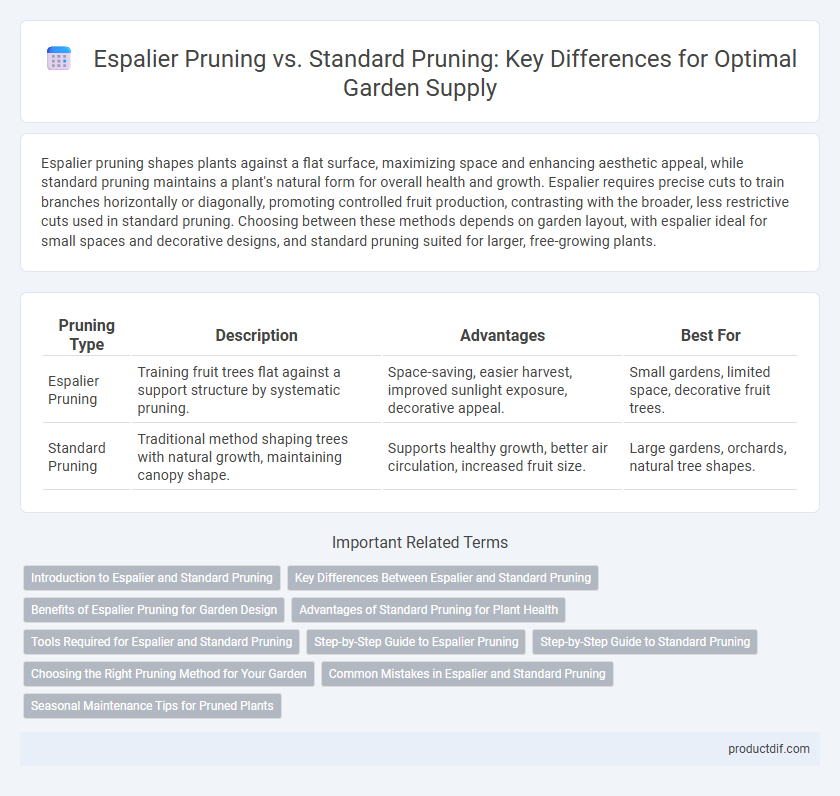Espalier pruning shapes plants against a flat surface, maximizing space and enhancing aesthetic appeal, while standard pruning maintains a plant's natural form for overall health and growth. Espalier requires precise cuts to train branches horizontally or diagonally, promoting controlled fruit production, contrasting with the broader, less restrictive cuts used in standard pruning. Choosing between these methods depends on garden layout, with espalier ideal for small spaces and decorative designs, and standard pruning suited for larger, free-growing plants.
Table of Comparison
| Pruning Type | Description | Advantages | Best For |
|---|---|---|---|
| Espalier Pruning | Training fruit trees flat against a support structure by systematic pruning. | Space-saving, easier harvest, improved sunlight exposure, decorative appeal. | Small gardens, limited space, decorative fruit trees. |
| Standard Pruning | Traditional method shaping trees with natural growth, maintaining canopy shape. | Supports healthy growth, better air circulation, increased fruit size. | Large gardens, orchards, natural tree shapes. |
Introduction to Espalier and Standard Pruning
Espalier pruning is a horticultural technique that trains trees to grow flat against a structure, maximizing space and enhancing fruit production in limited areas. Standard pruning involves shaping trees to grow naturally with a central leader or open center, promoting robust canopy development and overall tree health. Both methods improve air circulation and sunlight penetration but serve different landscaping and yield objectives.
Key Differences Between Espalier and Standard Pruning
Espalier pruning involves training fruit trees to grow flat against a support, maximizing space and increasing sunlight exposure, while standard pruning allows natural growth with a rounded shape, promoting overall tree health. Espalier requires precise, regular pruning to maintain a specific pattern, whereas standard pruning focuses on removing dead or overcrowded branches to enhance airflow and fruit production. The fundamental difference lies in espalier's structured design for aesthetic and spatial efficiency versus the conventional, more organic approach of standard pruning.
Benefits of Espalier Pruning for Garden Design
Espalier pruning enhances garden design by training trees and shrubs to grow flat against a structure, maximizing space efficiency and creating visually striking shapes. This technique improves air circulation and sunlight penetration, promoting healthier growth and easier maintenance compared to standard pruning. Espalier also offers increased fruit production in limited areas, making it ideal for small or urban gardens seeking both beauty and productivity.
Advantages of Standard Pruning for Plant Health
Standard pruning promotes better air circulation and sunlight penetration, reducing the risk of fungal diseases and pest infestations. It encourages robust branch development and stronger structural growth, enhancing the plant's overall resilience. This method simplifies maintenance, allowing gardeners to easily remove dead or damaged wood, which supports healthier and more vigorous plants.
Tools Required for Espalier and Standard Pruning
Espalier pruning requires precise hand tools such as sharp pruning shears, grafting knives, and sturdy plant ties to train branches onto support structures for a flat, decorative growth pattern. Standard pruning often utilizes heavier tools, including loppers and pruning saws, to manage larger branches for overall tree health and shape. Both techniques demand quality, well-maintained equipment, but espalier pruning emphasizes precision tools for careful branch placement, while standard pruning focuses on strength and versatility.
Step-by-Step Guide to Espalier Pruning
Espalier pruning involves training trees to grow flat against a support, maximizing space and sunlight exposure through precise cuts at each step. Begin by selecting a young, flexible branch, remove any vertical shoots, and tie the main branches horizontally along a trellis or wire frame. Regularly prune side shoots and maintain the desired shape to encourage fruit production and improve air circulation compared to standard pruning methods that allow more natural, bushy growth.
Step-by-Step Guide to Standard Pruning
Standard pruning involves removing dead or diseased branches, thinning crowded areas, and shaping the plant to promote healthy growth. Begin by cutting away crossing or inward-growing branches, followed by trimming back overly long shoots to maintain balance and structure. This method enhances air circulation and sunlight penetration, crucial for strengthening the garden plant's vitality and fruit production.
Choosing the Right Pruning Method for Your Garden
Espalier pruning shapes trees flat against a support, maximizing space efficiency and ideal for small gardens or decorative purposes. Standard pruning encourages natural tree growth, promoting stronger branches and higher fruit yields in open garden spaces. Selecting the right pruning method depends on garden size, desired aesthetics, and fruit production goals.
Common Mistakes in Espalier and Standard Pruning
Common mistakes in espalier pruning include cutting too aggressively, which can stunt growth and reduce fruit production, and failing to maintain proper framework alignment, leading to uneven branch development. In standard pruning, errors often involve removing too much foliage at once, weakening the plant's ability to photosynthesize, and neglecting to prune dead or diseased wood, which can spread infections. Proper timing and technique tailored to each pruning style are essential to optimize plant health and maximize yield in garden supply management.
Seasonal Maintenance Tips for Pruned Plants
Espalier pruning requires precise seasonal maintenance to promote strong horizontal growth and improve air circulation, typically conducted in late winter or early spring before new growth begins. Standard pruning often involves removing dead or overgrown branches during dormant seasons to maintain plant shape and health, with summer trimming encouraging flowering and fruit production. Proper timing and technique for each pruning style optimize plant vigor, disease resistance, and yield in garden environments.
Espalier pruning vs Standard pruning Infographic

 productdif.com
productdif.com